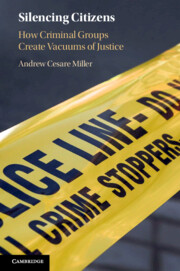Refine search
Actions for selected content:
23 results
9 - Zoning’s Racial Innocence and the Imperatives of Segregation
-
-
- Book:
- Racial Justice in American Land Use
- Published online:
- 19 September 2025
- Print publication:
- 09 October 2025, pp 205-229
-
- Chapter
- Export citation
6 - Confronting Revolution
- from Part III - Courts for a New Empire, 1816–1825
-
- Book:
- The Nation at Sea
- Published online:
- 28 August 2025
- Print publication:
- 11 September 2025, pp 191-227
-
- Chapter
- Export citation

Silencing Citizens
- How Criminal Groups Create Vacuums of Justice
-
- Published online:
- 04 September 2024
- Print publication:
- 23 May 2024
Conclusion
-
- Book:
- Silencing Citizens
- Published online:
- 04 September 2024
- Print publication:
- 23 May 2024, pp 259-276
-
- Chapter
- Export citation
4 - Evidence
- from Part II - How Criminal Groups Prevent Cooperation
-
- Book:
- Silencing Citizens
- Published online:
- 04 September 2024
- Print publication:
- 23 May 2024, pp 127-151
-
- Chapter
- Export citation
2 - Research Design and Definitions
- from Part I - Why Police–Citizen Cooperation Matters
-
- Book:
- Silencing Citizens
- Published online:
- 04 September 2024
- Print publication:
- 23 May 2024, pp 61-86
-
- Chapter
- Export citation
7 - Evidence
- from Part III - Interventions for Promoting Cooperation
-
- Book:
- Silencing Citizens
- Published online:
- 04 September 2024
- Print publication:
- 23 May 2024, pp 217-238
-
- Chapter
- Export citation
Introduction
-
- Book:
- Silencing Citizens
- Published online:
- 04 September 2024
- Print publication:
- 23 May 2024, pp 1-24
-
- Chapter
- Export citation
Chapter 1 - Baltimore
- from Part I - Places
-
-
- Book:
- Frederick Douglass in Context
- Published online:
- 16 June 2021
- Print publication:
- 08 July 2021, pp 9-20
-
- Chapter
- Export citation
Chapter 6 - The Millington Bank
-
- Book:
- Williams' Gang
- Published online:
- 16 January 2020
- Print publication:
- 16 January 2020, pp 137-160
-
- Chapter
- Export citation
6 - Prostitution, Policing, and Property Rights in the Gilded Age
- from Part II - Regulating and Policing the Sex Trade
-
- Book:
- Bawdy City
- Published online:
- 06 December 2019
- Print publication:
- 02 January 2020, pp 170-196
-
- Chapter
- Export citation
1 - Selling Sex in the Early Republic
- from Part I - The Rise of Prostitution in the Early Republic
-
- Book:
- Bawdy City
- Published online:
- 06 December 2019
- Print publication:
- 02 January 2020, pp 23-47
-
- Chapter
-
- You have access
- HTML
- Export citation
8 - Rise of Urban Leisure and the Decline of Brothels
- from Part III - Change and Decline in the Brothel Trade
-
- Book:
- Bawdy City
- Published online:
- 06 December 2019
- Print publication:
- 02 January 2020, pp 228-256
-
- Chapter
- Export citation
2 - The Expansion of Prostitution and the Rise of the Brothel
- from Part I - The Rise of Prostitution in the Early Republic
-
- Book:
- Bawdy City
- Published online:
- 06 December 2019
- Print publication:
- 02 January 2020, pp 48-76
-
- Chapter
- Export citation
5 - “Our Patriotic Friends”
- from Part II - Regulating and Policing the Sex Trade
-
- Book:
- Bawdy City
- Published online:
- 06 December 2019
- Print publication:
- 02 January 2020, pp 146-169
-
- Chapter
- Export citation
Introduction
-
- Book:
- Bawdy City
- Published online:
- 06 December 2019
- Print publication:
- 02 January 2020, pp 1-20
-
- Chapter
- Export citation
4 - Policing the Expanding Sex Trade
- from Part II - Regulating and Policing the Sex Trade
-
- Book:
- Bawdy City
- Published online:
- 06 December 2019
- Print publication:
- 02 January 2020, pp 111-145
-
- Chapter
- Export citation
3 - Brothel Prostitution and Antebellum Urban Commercial Networks
- from Part I - The Rise of Prostitution in the Early Republic
-
- Book:
- Bawdy City
- Published online:
- 06 December 2019
- Print publication:
- 02 January 2020, pp 77-108
-
- Chapter
- Export citation
9 - The End of an Era
- from Part III - Change and Decline in the Brothel Trade
-
- Book:
- Bawdy City
- Published online:
- 06 December 2019
- Print publication:
- 02 January 2020, pp 257-292
-
- Chapter
- Export citation
7 - Black Baltimoreans and the Bawdy Trade
- from Part III - Change and Decline in the Brothel Trade
-
- Book:
- Bawdy City
- Published online:
- 06 December 2019
- Print publication:
- 02 January 2020, pp 199-227
-
- Chapter
- Export citation
